In SEO, everything is measurable. From impressions to clicks and sessions, there are dozens of SEO metrics you can track and monitor.
But here’s the catch: not all metrics deserve your attention. Some are important, but others are just vanity numbers that look impressive on a report but don’t actually tell you if your strategy is working.
Instead of wasting your time tracking every metric under the moon, focus on a selected few that actually help you make better decisions.
Why You Should Focus on the Right Metrics
Monitoring too many metrics often creates more confusion than clarity. You end up with bloated dashboards, conflicting signals, and no clear story to tell your team or clients.
I’ve learned this lesson the hard way. After creating countless SEO reports for my clients at Position Digital, I’ve realized that the real value of SEO metrics lies in their ability to guide decision-making processes.
The right metrics show you:
- What’s working so you can double down on winning strategies.
- Where you’re slipping so you can take immediate action before performance drops further.
- How SEO contributes to business goals like leads, revenue, and customer acquisition.
By focusing on high-impact metrics, you’ll get the clarity needed to fine-tune your strategy and get your website to the top of Google and AI-powered search.
9 SEO Metrics That Actually Matter
These are the metrics that help you measure real progress, uncover weak spots, and tie your efforts back to business growth.
Let’s start with the most fundamental one:
1. Organic Traffic
Organic traffic is the number of visitors who land on your website through non-paid search engine results.
Why it’s important
If your organic traffic is growing, that’s a good indicator that your SEO efforts are paying off. It shows that your pages not only rank well for relevant keywords, but also attract searchers who find your content interesting and valuable enough to click through.
Unlike paid clicks from PPC campaigns, organic traffic is free – and it can continue to grow without increasing your ad spend, making it one of the most sustainable sources of long-term visitors and leads.
How to track it
Google Search Console (GSC) gives you the most accurate data on your organic traffic from Google. Inside the Performance tab, you can see the total clicks your website gets over time:
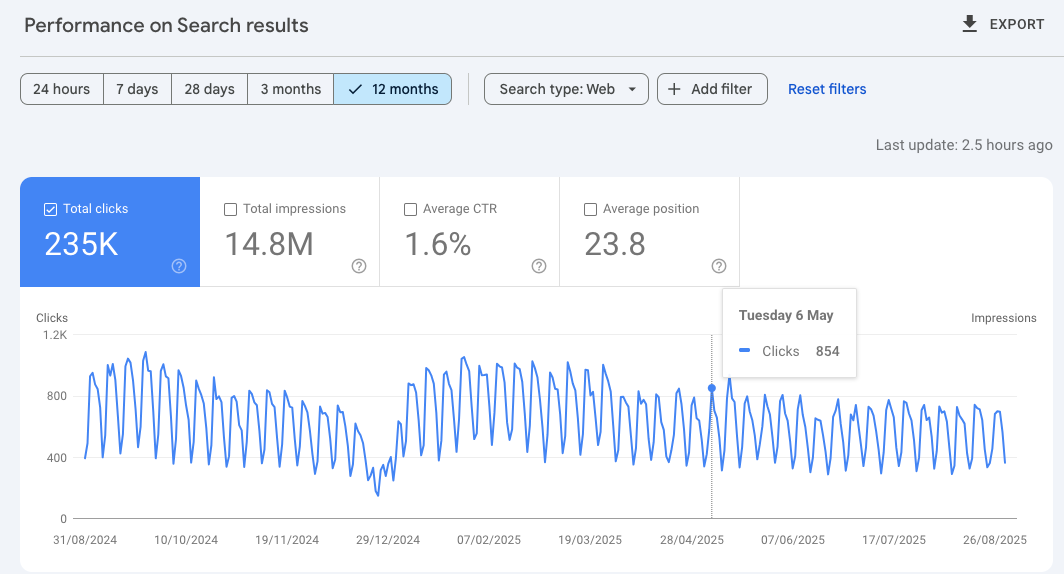
The only problem is that GSC data isn’t updated in real time. It generally takes around 3-4 days for Google to update the reports.
If you want to monitor your traffic daily, SpyFu is an excellent alternative. The newly launched My Sites dashboard gives you fresh performance updates in real time, so you can spot ranking shifts and click fluctuations as they happen.

For those looking to track organic traffic from different search engines beyond just Google, use Google Analytics 4 (GA4).
Under Reports → Acquisition → Traffic acquisition, filter by “Session source/medium” to get a complete view of your organic visits, whether they come from Google, Bing, DuckDuckGo, or others.
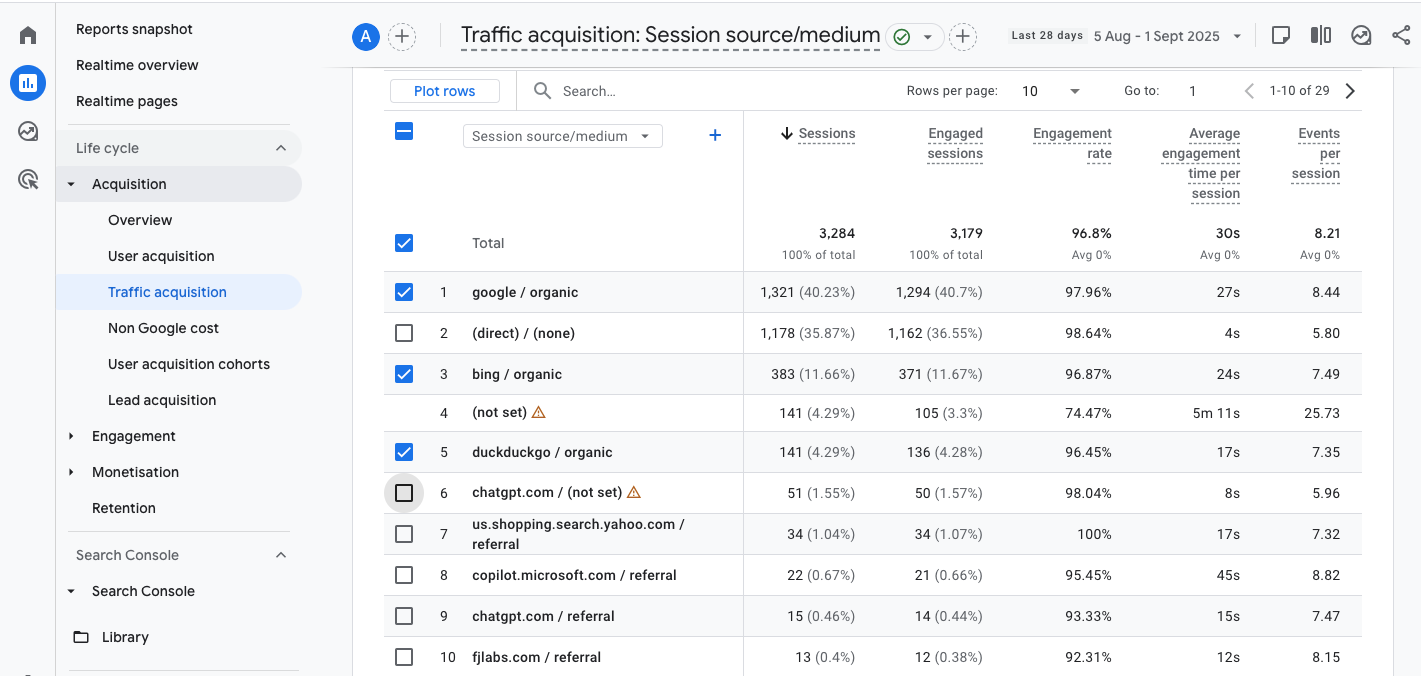
2. Keyword Rankings
Keyword rankings represent the organic SERP positions of your pages for particular search queries.
Why it’s important
The higher your site ranks for a keyword, the more visible it becomes to searchers, leading to more clicks and traffic. In fact, a study by Backlinko suggested that pages that rank first on Google get 27.6% of all clicks.
However, it’s also important to note that not all rankings are equally valuable. Securing the top position for an irrelevant keyword may have little business impact, while ranking third for a high-intent term could drive significant leads or sales.
The more relevant a keyword is to your product or service, the more valuable it is to rank for.
How to track it
SpyFu’s Rank Tracking tool makes it easy to track rankings of individual keywords. Simply add a keyword to monitor progress, view historical data, and receive weekly updates on its SERP positions.
If you want to build authority in certain topics, you can also organize similar keywords into groups or clusters and compare their performance over time. This approach helps you see whether you’re gaining visibility across an entire theme, not just for one or two isolated terms.
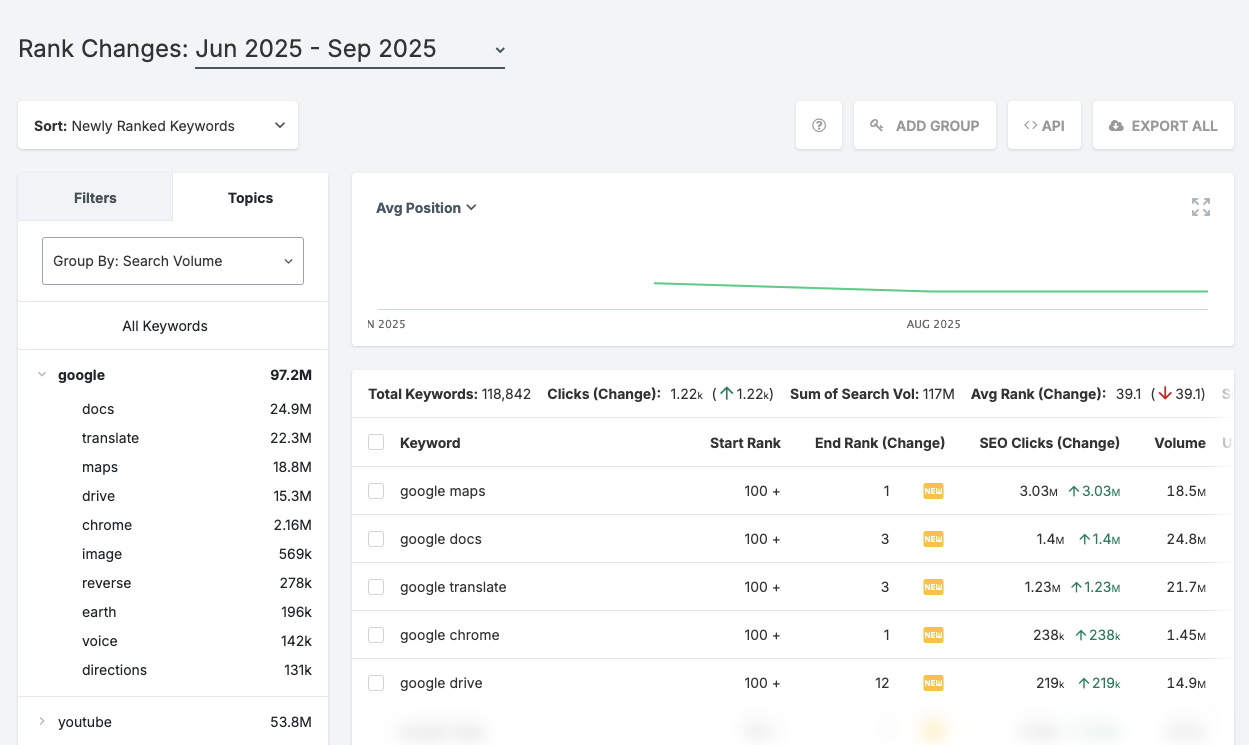
Julia Kranz, Senior Content Marketing Manager at Seobility, explains why this approach is crucial:
"Don't just monitor your rankings and traffic at the keyword level. Group your keywords into clusters based on the main topics and themes that you want to be associated with. This will give you a better overall picture of what's working well and what isn't than looking at isolated terms would."
SpyFu also makes it easy to spy on your competitors’ keywords, helping you uncover gaps in your strategy and find new opportunities to rank.
3. Traffic Value
Traffic value estimates how much your organic traffic would cost if you had to pay for it through PPC ads.
Why it’s important
If you’re trying to convince your boss to invest in SEO instead of Google Ads, this metric can be a game-changer. It puts a clear dollar figure on the traffic your SEO brings in, turning abstract numbers like clicks into real business value.
This makes it much easier to communicate SEO’s impact to leaders and stakeholders who care about ROI. A rising traffic value shows that your SEO efforts are generating results that would otherwise require a larger advertising budget.
How to track it
You can see any website’s traffic value from the SEO Overview tab inside the SpyFu dashboard.

If you want to know the traffic value of individual pages, you can use tools like Ahrefs. Open the Site Explorer tab, enter your domain, click the Top Pages report, and filter the view by “Value” to see your most valuable pages.

4. Share of Voice
Share of Voice (SOV) measures how much search traffic your website captures compared to the total traffic available for your target keywords.
Why it’s important
Think of SOV as your SEO market share. It shows your current slice of the traffic pie – how much visibility you own compared to your competitors.
A growing SOV means you’re expanding your presence in search and winning clicks that might otherwise go to rivals. On the flip side, a decreasing SOV signals that competitors are gaining ground, even if your traffic numbers look stable.
How to track it
Different tools might have different names for this metric. Some call it visibility score, while others use Share of Voice or traffic market share.
No matter the label, the concept is the same: measuring the percentage of search traffic your site wins compared to the total available.
With SpyFu, you simply need to enter your domain. The tool will then automatically add your top competitors and compare how much traffic each site captures.

You can also see a breakdown of:
- Core Keywords: Search queries where both you and your competitors rank.
- All Keywords: A complete list of every keyword driving visibility across the compared domains.
- Missing Keywords: Particular terms where your competitors rank, but your site doesn’t.
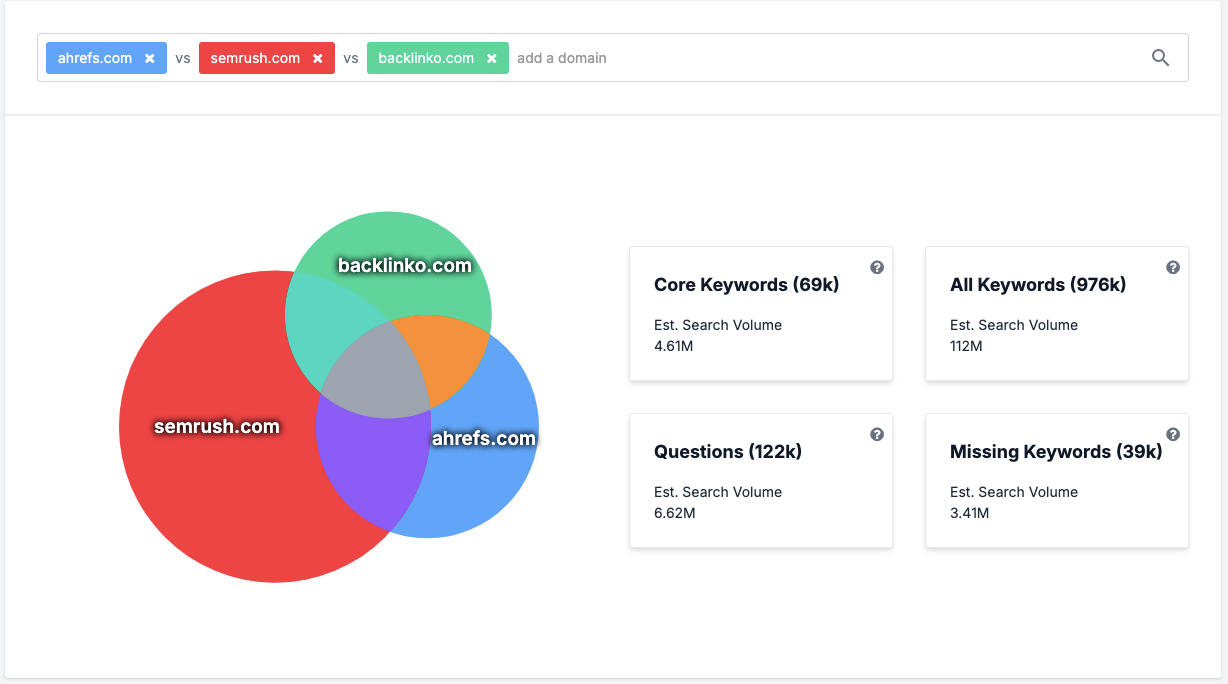
This gives you a clear picture of your current SEO market share and helps you identify exactly where to focus your efforts to gain ground.
5. Conversions
Conversions are the actions you want visitors to take on your website that directly support your business goals. These include making a purchase, filling out a form, signing up for a newsletter, or downloading a resource.
Why it’s important
Traffic alone isn’t enough. You could be driving thousands of visitors to your site, but if none of them are signing up, downloading, or buying, your SEO isn’t delivering real business results.
High conversions are a good indicator that your content serves search intent well and provides a good user experience. In contrast, if conversions are low despite strong rankings and traffic, it’s a sign you need to revisit content quality and CTAs.
How to track it
Tracking organic traffic conversions can be tricky because “conversion” means different things depending on your business model. So, the first step is to define what counts as a conversion for your site.
Here are some examples by niche or website type:
- E-commerce sites: Track purchases, add-to-carts, and checkout completions.
- SaaS companies: Measure free trial sign-ups, demo requests, or subscription upgrades.
- B2B service providers: Track lead form submissions, quote requests, or contact button clicks.
- Publishers or media sites: Monitor newsletter sign-ups, content downloads, or ad clicks.
- Local businesses: Track phone call clicks, map directions, or online booking completions.
After you know what to track, set it up as a key event in Google Analytics 4. Some events, like form submissions and in-app purchases, are collected automatically by GA4. But if your desired action isn’t included, you’ll need to create a custom event.
Once set up, you can track your conversions via Reports → Engagement → Events.
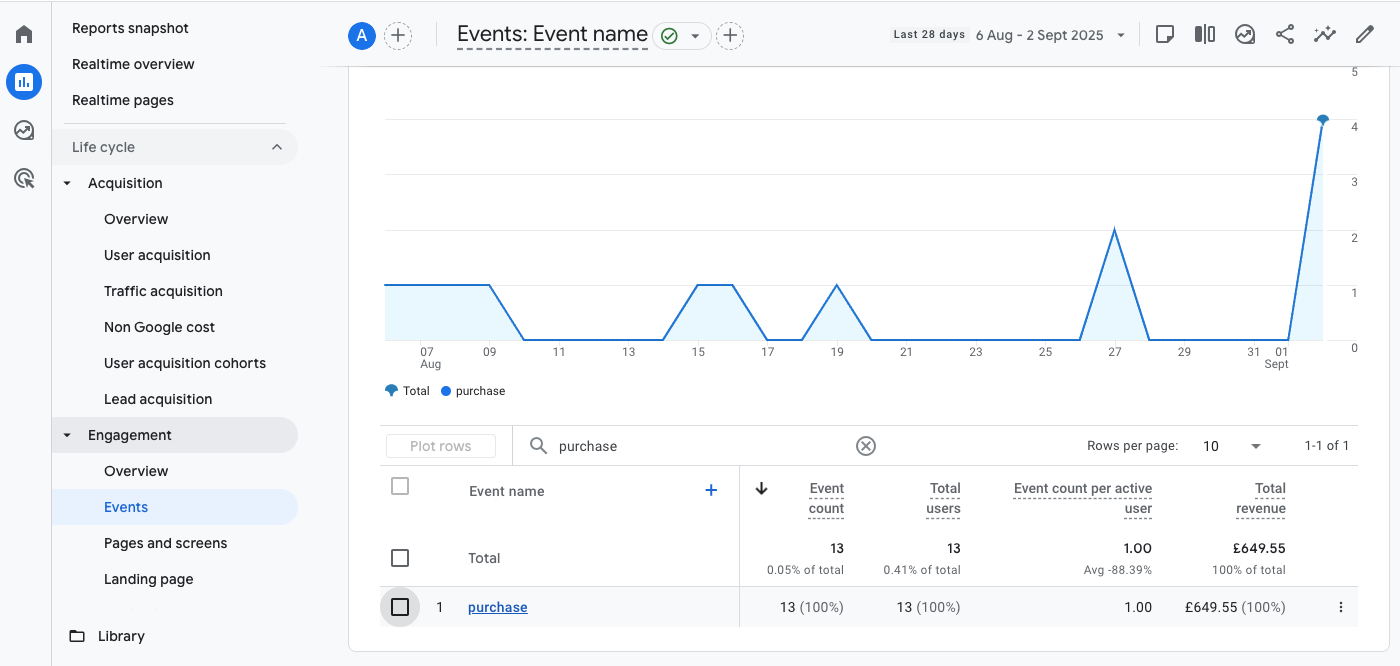
If you’d like to see conversions broken down by page, simply switch to the Landing Page tab to view performance at the page level.
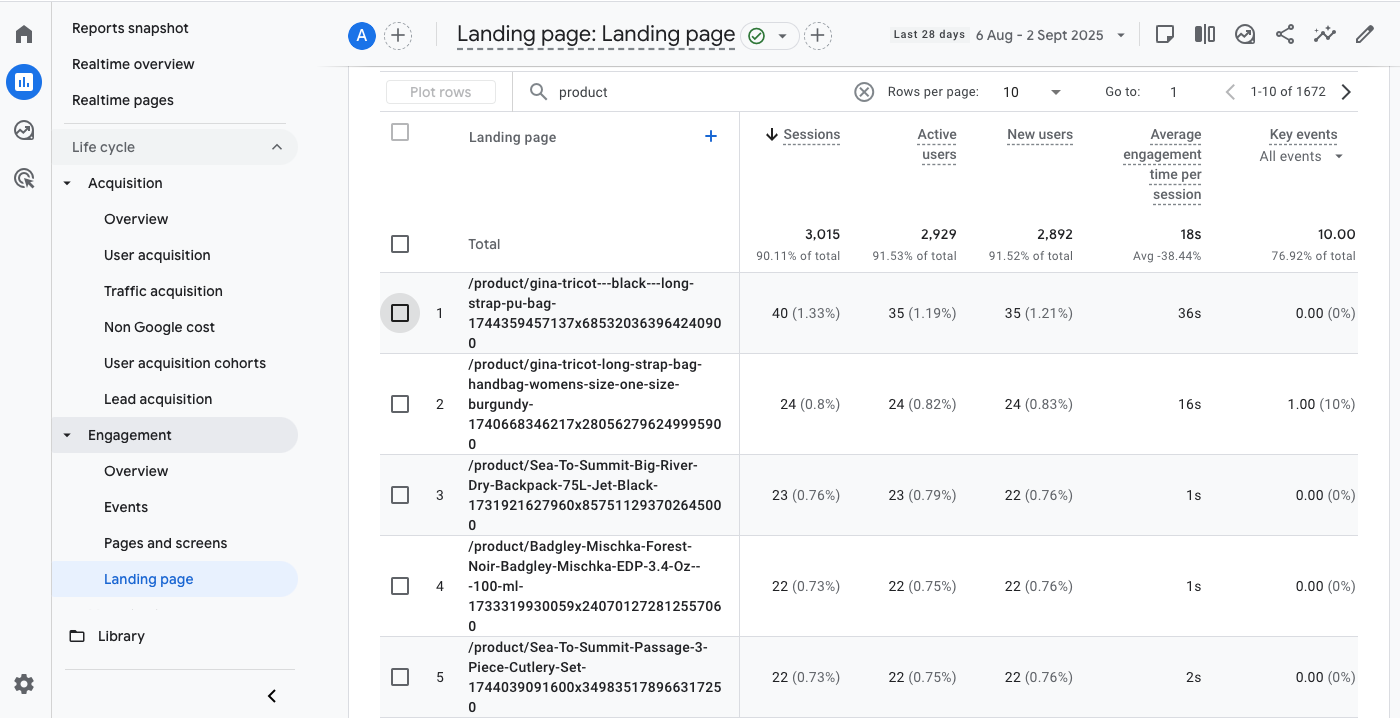
Still struggling with GA4 setup? Feel free to check out our Google Analytics guide for beginners.
6. Backlinks
Backlinks are links from other websites that point to your pages. They act as votes of confidence, signaling to search engines that your content is credible, authoritative, and worth ranking.
However, not all backlinks are created equal. Links from relevant, high-authority sites carry much more weight than dozens of low-quality ones.
Why it’s important
Backlinks remain one of Google’s strongest ranking factors. Acquiring high-quality backlinks can help you:
- Improve domain authority and overall search visibility
- Rank faster for competitive keywords
- Drive referral traffic from relevant websites
- Build credibility in your niche
On the flip side, toxic or spammy backlinks can hurt your site’s performance. That’s why monitoring your backlink profile is important to identify and remove bad backlinks.
How to track it
The Backlinks feature in SpyFu shows you a list of URLs that are linking to your website, along with their organic traffic and domain authority.
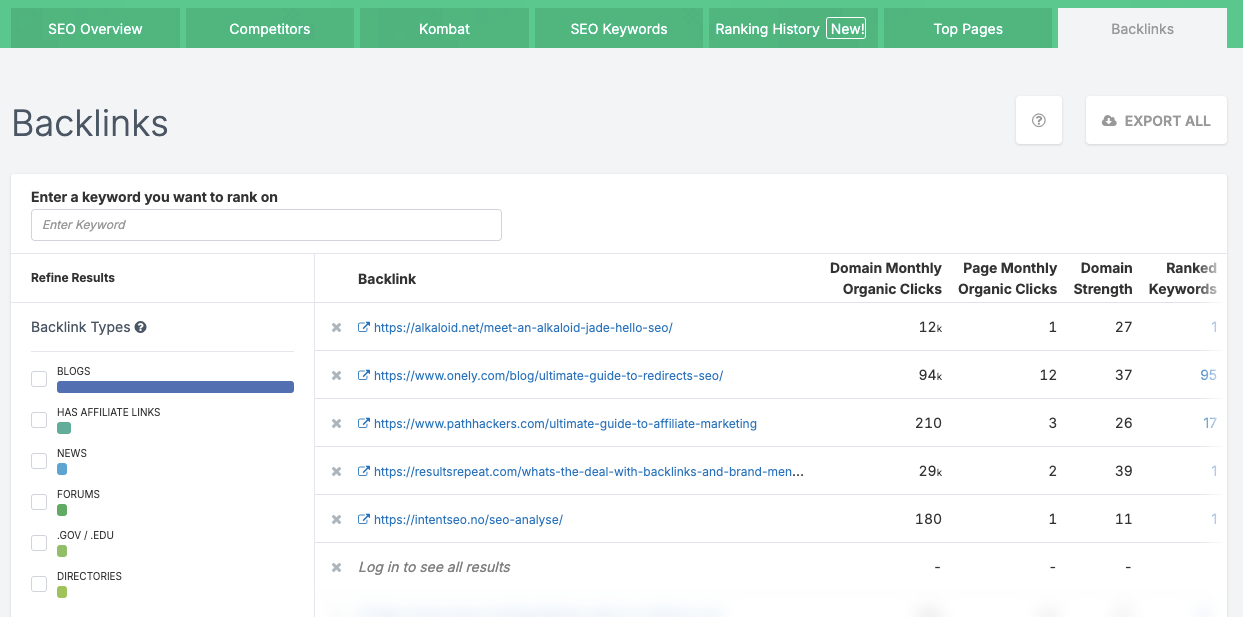
You can also analyze the backlink profile of your competitors, and uncover high-authority sites linking to them but not you. This presents great outreach opportunities, since those sites are already open to linking to content in your niche.
That being said, if you want to review the exact anchor text being used or monitor new and lost backlinks over time, you’ll need to complement SpyFu with other tools like Ahrefs or SEMrush for more granular tracking.
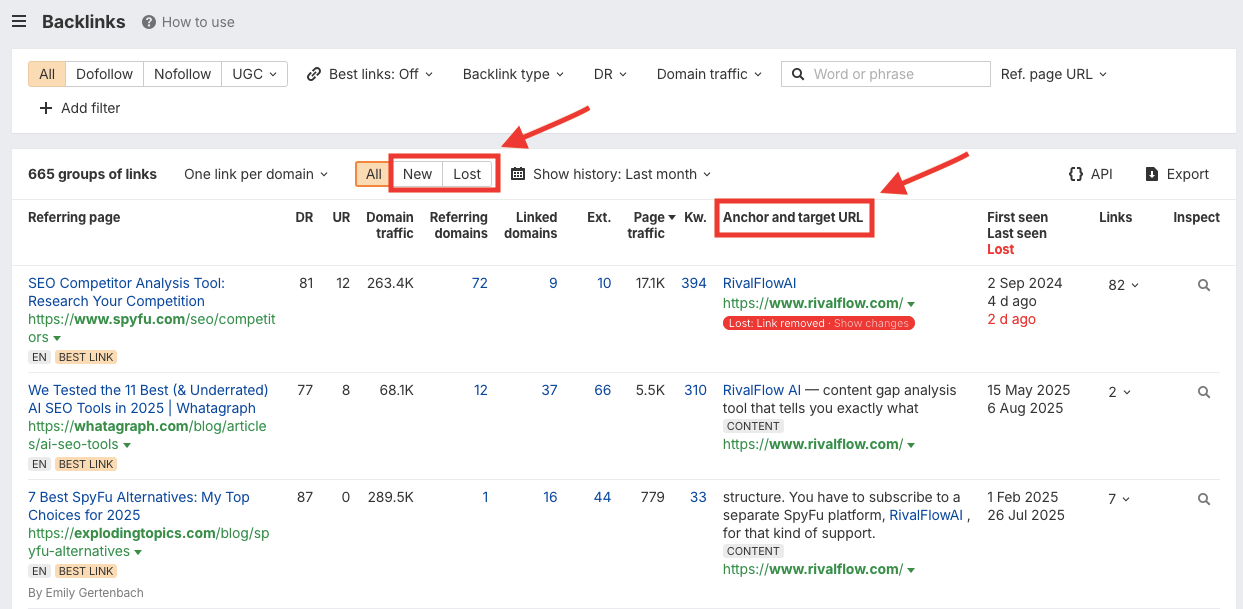
7. Indexed Pages
Indexed pages are URLs on your website that search engines have discovered, crawled, and added to their index.
Why it’s important
Search engines work by crawling, indexing, and ranking web pages. So, if your page isn’t indexed in the first place, it might as well be invisible to Google and users.
That’s why keeping an eye on your indexed pages is essential. It ensures your content is discoverable and eligible to appear in search results.
As you publish more content, you want to see the number of indexed pages gradually increase. A sudden dip in indexed pages could indicate technical problems like crawl errors, blocked resources, or accidental noindex tags.
How to track it
In Google Search Console, head to Indexing → Pages to see the total number of your indexed and not indexed pages.

Scroll down a bit, and you’ll find a list of common reasons why certain pages aren’t indexed. You can also click the numbers next to each issue to view the exact URLs that are being affected.
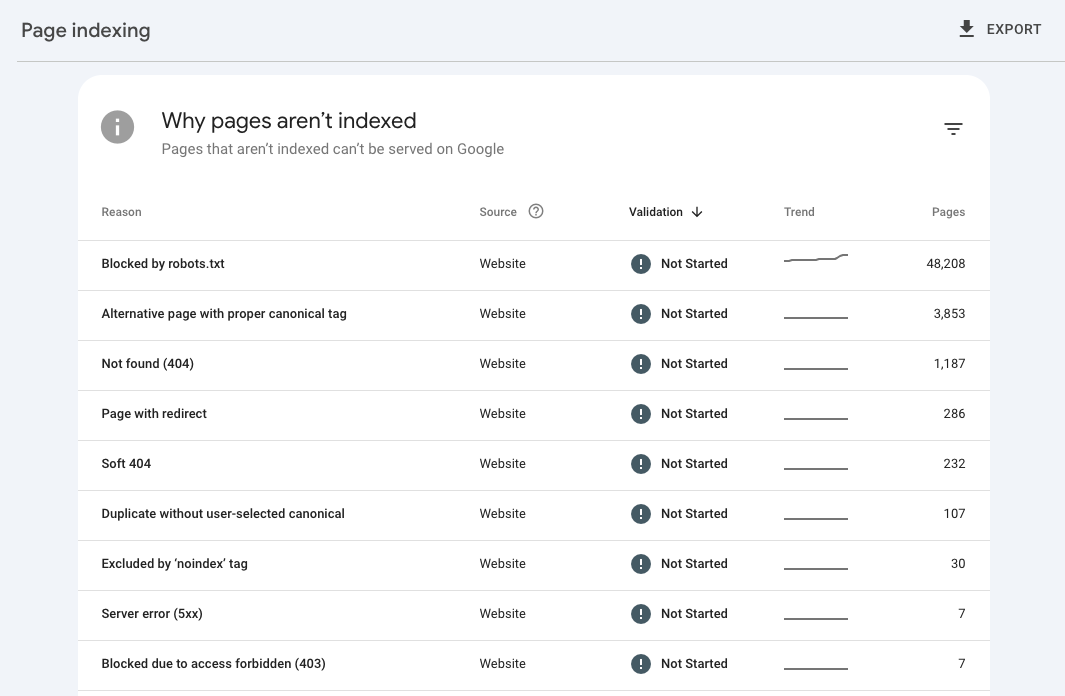
8. Core Web Vitals
“Another thing that's often overlooked but can be super powerful is regularly checking the site's Core Web Vitals, especially since Google's constantly tweaking its algorithms to be more user-friendly,” said Elsid Malasi, SEO Manager & Technical SEO Specialist at Shero Commerce.
Core Web Vitals (CWV) are a set of performance metrics that measure how fast, stable, and responsive your website feels to users.
Those include:
- Largest Contentful Paint (LCP): How quickly the main content loads.
- Cumulative Layout Shift (CLS): How visually stable the page is while loading.
- Interaction to Next Paint (INP): How quickly the site responds to user actions.
Why it’s important
Core Web Vitals are a Google ranking signal, and they have a huge impact on user experience, something that Google cares about deeply.
Good CWV scores mean faster load times, stable layouts, and smoother interactions, all of which reduce bounce rates, keep users engaged, and increase the likelihood of conversions.
On the other hand, poor Core Web Vitals can frustrate visitors, leading them to abandon your site before they ever read your content or complete an action.
How to track it
Go to Experience → Core Web Vitals from your GSC account. This report shows which URLs are performing well, which need improvement, and which are failing – separately for mobile and desktop. It also groups pages by issue so you can fix multiple URLs at once.

When you click Open Report, you’ll see detailed diagnostics for each problem, including examples of affected pages. From there, you can drill down into the specific Core Web Vital that’s failing (like LCP or CLS) and follow Google’s recommendations for fixes.
Other tools to monitor Core Web Vitals include PageSpeed Insights, Lighthouse, and GTmetrix.
When you click Open Report, you’ll see detailed diagnostics for each problem, including examples of affected pages. From there, you can drill down into the specific Core Web Vital that’s failing (like LCP or CLS) and follow Google’s recommendations for fixes.
Other tools to monitor Core Web Vitals include PageSpeed Insights, Lighthouse, and GTmetrix.
9. Technical SEO Issues
Technical SEO issues are problems within your website’s infrastructure that prevent search engines from crawling, indexing, or understanding your content effectively.
Why it’s important
Technical SEO is the foundation of your entire search strategy. Without it, even the best content and strongest backlinks won’t reach their potential.
As Tomáš Ďurovič, Technical SEO Specialist at Spotibo, puts it:
“Our website is constantly evolving, and during this process, errors can occur that can be easily overlooked. That's why we place great emphasis on technical SEO monitoring.”
By constantly monitoring and fixing technical SEO issues on your website, you provide the best experience possible for both search engine bots and human users.
How to track it
It’s a good practice to run a thorough site audit once every 3 to 6 months. Granted, this process takes a lot of time, effort, collaboration, and a mix of different tools to pull off, but the payoff is worth it.
Want the step-by-step breakdown? Check out our video guide on running a full technical SEO audit, where we walk you through the exact process and tools to use.
Bonus: 5 Important Metrics for AI Search Visibility
We’ve entered the era of zero-click search. Users are getting answers directly from AI Overviews and LLMs without having to visit your website. That’s why clicks are dropping across the board.
As Julia Kranz explains:
"AI search is changing the way online searches work. Looking only at actual traffic no longer gives you a complete picture of how your content contributes to your company's success, because website clicks are generally lower in AI-powered search results."
This shift means traditional SEO metrics like traffic and rankings only tell part of the story. To truly understand your search visibility, there’s an entirely new layer of GEO (generative engine optimization) metrics to measure.
1. AI Brand Mentions
AI brand mentions refer to instances when your company, product, or content is referenced within AI Overviews, LLM answers, or other AI-driven search results.
Why it’s important
Being consistently mentioned in AI answers builds brand authority and awareness, even when users don’t click directly to your website.
Imagine if someone asks ChatGPT or Google’s AI Mode for product recommendations, and it’s your brand that consistently shows up in the answers. Even without a click, you’ve positioned yourself as a trusted option in the user’s mind.
Over time, this visibility can influence purchasing decisions, increase branded searches, and strengthen your overall reputation.
Monitoring AI brand mentions also helps you identify LLM hallucinations – instances where AI generates inaccurate or misleading information about your brand. Left unchecked, these errors can damage credibility and mislead potential customers.
How to track it
If you simply want to track your AI brand mentions in ChatGPT, you can use SpyFu’s AI Tracker. This is a great way to gauge whether your brand is represented accurately in ChatGPT answers.
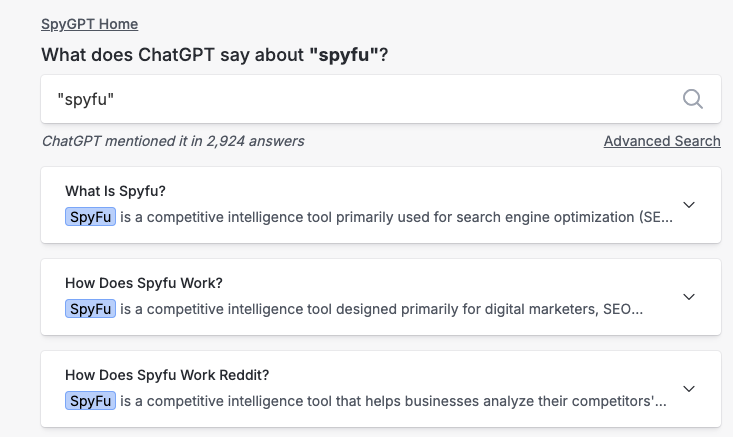
But if you want to track your brand visibility across different LLMs and AI search engines, tools like Ahrefs Brand Radar can give you a broader view.
It shows you how many times your brand is mentioned in AI Overviews, as well as ChatGPT, Perplexity, and Gemini responses.

Image source: Ahrefs
You can also check the response for each search query to identify inaccurate or incomplete mentions that might need correcting.

Image source: Writesonic
2. AI Citation Frequency
AI citation frequency measures how often your website, brand, or specific content is cited as a source within AI-generated answers.
Unlike brand mentions, which track whether your name appears at all, citation frequency focuses on direct references or attributions (e.g., clickable citations, footnotes, or source links) that AI engines use to back up their answers.
Why it’s important
Citation frequency is one of the clearest indicators of trust and authority in the eyes of AI engines. If an LLM consistently cites your content, it means the system views your site as a credible source of truth.
And since citations often include links back to your pages, they don’t just boost visibility, but also create a pathway for referral traffic. Some users will click through citations to verify information or dive deeper, turning your AI visibility into tangible visits and potential leads.
How to track it
Again, Ahrefs Brand Radar is a solid tool for tracking AI citations for your domain across different AI systems.
It shows how many times your domain secures AI citations on platforms like AI Overviews, ChatGPT, Perplexity, and Gemini, along with the specific pages being cited.
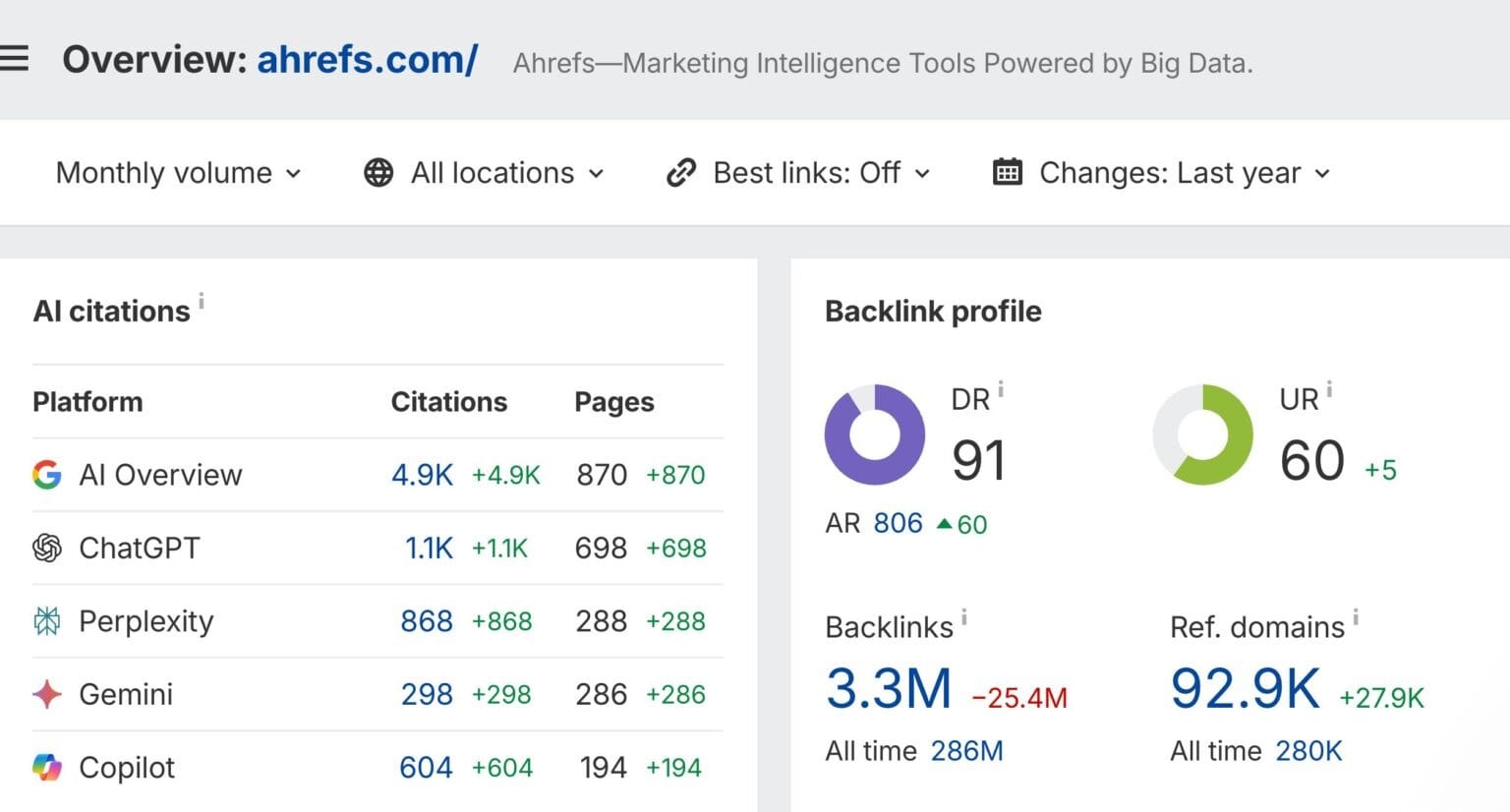
Image source: Ahrefs
3. AI Referral Traffic
AI referral traffic is the number of visitors who arrive at your website by clicking through citations or links in AI-generated answers.
Why it’s important
Google is still driving the most traffic to your website. But AI traffic is growing fast, and various studies suggest that visitors from AI are more likely to convert. According to Semrush, AI search visitors are 4.4 times more valuable than organic search traffic.
In most cases, that’s because users have already done their research within AI chatbots. So, by the time they land on your website, they’re past the consideration stage and ready to buy.
How to track it
You can track AI referral traffic by setting up a new channel and source in Google Analytics 4.
Here’s how:
- Head to Admin → Data Display → Channel Groups and copy the default channel group.
- Add a new channel called something like AI Traffic, and set the “source” condition to “matches regex”.
- Copy and paste these AI platforms into the provided field:
.*chatgpt\.com.*|.*perplexity.*|.*gemini\.google\.com.*|.*copilot\.microsoft\.com.*|.*openai\.com.*|.*claude\.ai.*|.*writesonic\.com.*|.*copy\.ai.*|.*deepseek\.com.*|.*huggingface\.co.*|.*bard\.google\.com*
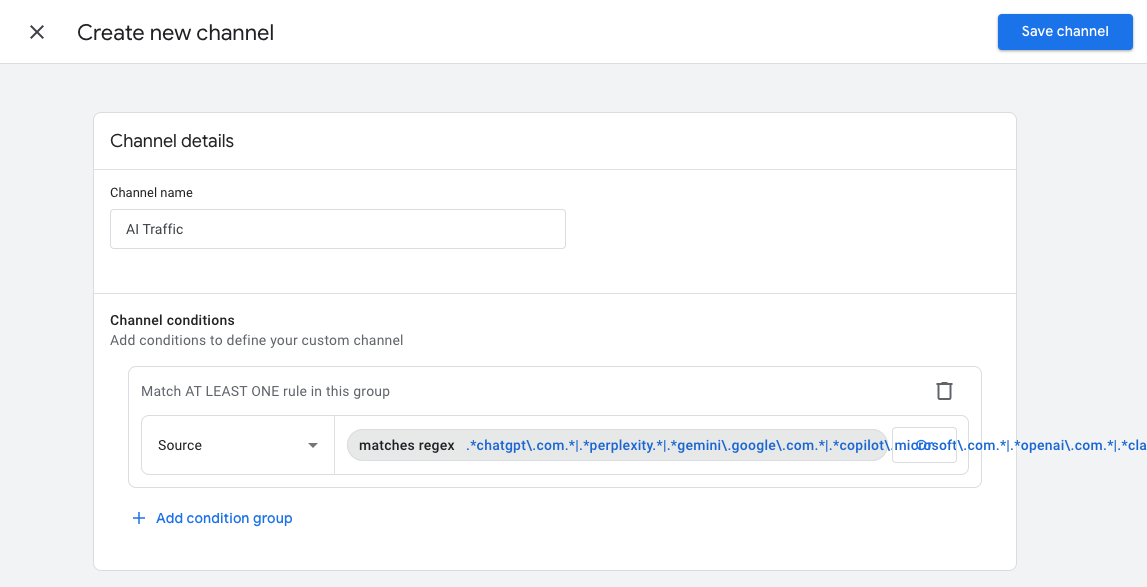
Once that’s in place, go to Reports → Acquisition → Traffic Acquisition, and select the AI traffic channel group. You’ll see exactly how many sessions come from AI platforms, and how they compare with the other traffic sources.
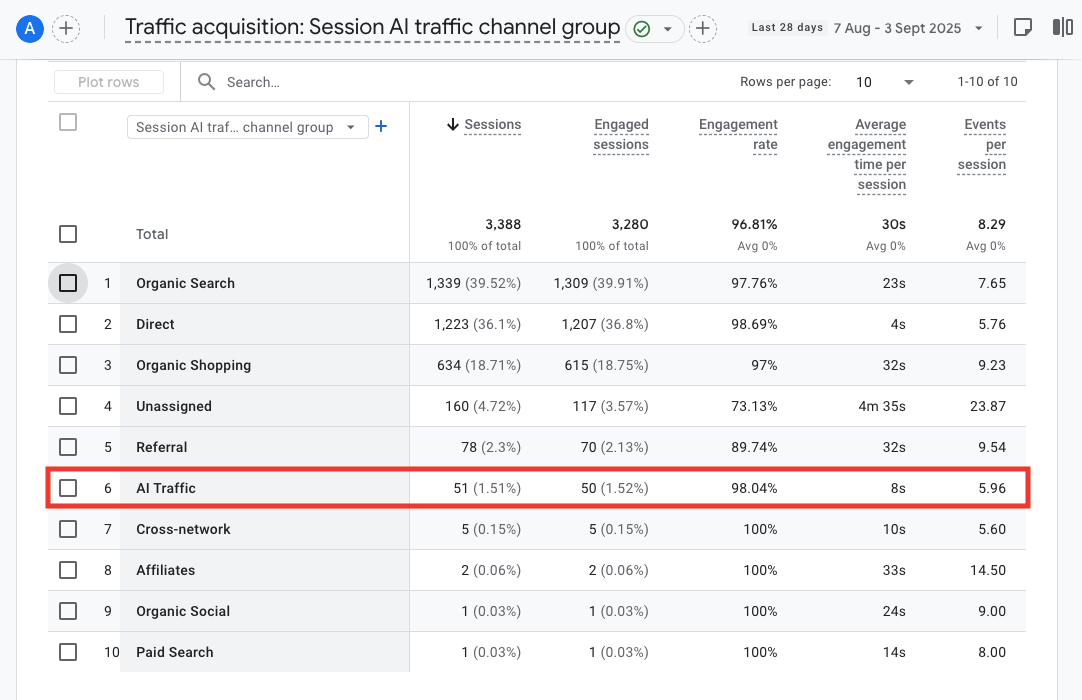
If you want to break down referral traffic by individual LLMs, you can create a separate channel for each AI model within your AI Traffic channel group. This way, clicks from ChatGPT, Perplexity, Gemini, and others will be tracked separately, giving you a clear view of which platforms drive the most valuable visitors.
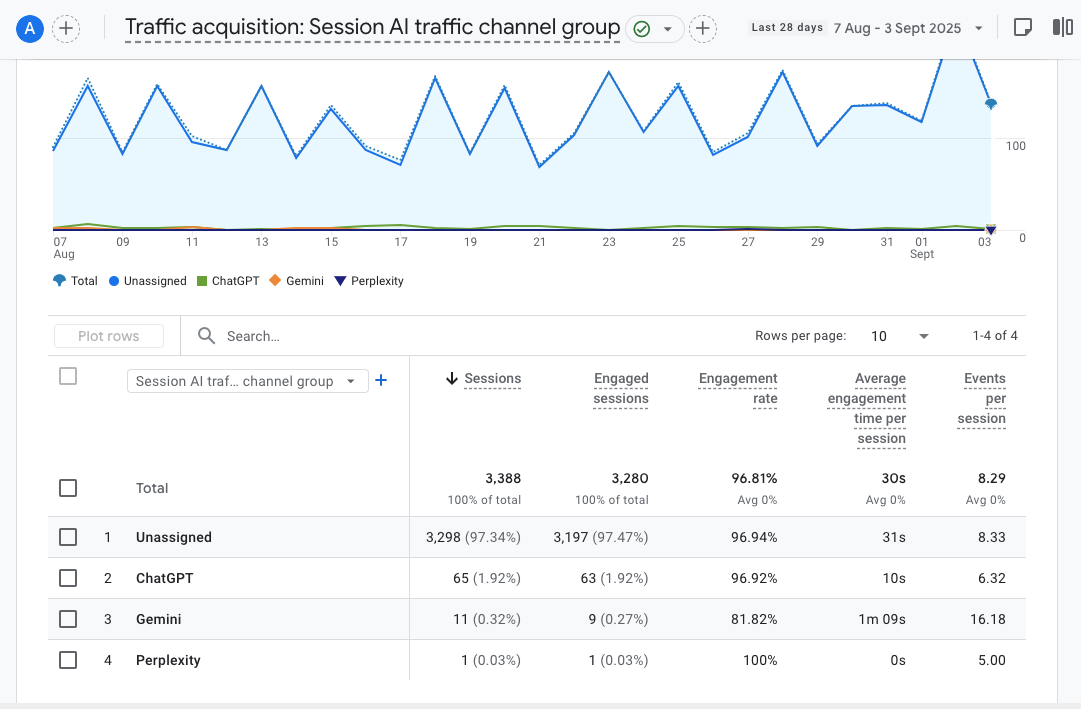
4. Branded Searches
Branded searches are queries that include your company’s name, products, or other brand-specific terms. For example, “SpyFu pricing,” or “HubSpot CRM demo.”
Why it’s important
Sometimes, users don’t click an AI citation right away. Instead, they’ll search your brand directly later. That’s why pairing the AI referral traffic metric with branded search growth can give you a better picture of your AI search visibility.
If you see a sudden spike in traffic from branded keywords, it may be a sign that your brand is gaining more visibility in AI-generated answers.
How to track it
In Google Search Console, go to Performance → Search Results and filter queries that include your brand name or product names. Track the total clicks for these branded queries over time.

As an alternative, you can use Ahrefs Brand Radar to monitor your branded search volume growth, and see how it stacks up against your competitors.

Image source: Ahrefs
5. AI Referral Conversions
AI referral conversions measure how many visitors from AI Overviews or LLM answers complete a desired action on your website.
Why it’s important
Tracking AI referral conversions helps you understand if this new traffic source is actually driving business results.
You’ll also know which AI models are bringing the most leads and conversions, so you can double down on those platforms and adjust your strategy for the ones that don’t perform as well.
How to track it
By now, I’d assume you’ve already set up your key events (conversions) and AI referral traffic channels in GA4. If you haven’t, check our Google Analytics guide for the complete steps.
You can see your AI referral conversions by opening the Traffic Acquisition report, selecting the AI Traffic channel group, and choosing the event(s) you want to track.

Want the Right Results? Start Tracking the Right Metrics
Tracking SEO performance can feel overwhelming when every tool throws dozens of graphs and numbers at you. The trick isn’t to measure everything; it’s to measure what matters most.
When you zero in on high-impact metrics like traffic value, share of voice, and conversions, you get a clear story of how SEO drives real business results. And as AI reshapes how people search, adding GEO metrics like brand mentions, citations, and AI referral traffic makes sure you’re not flying blind in the new search landscape.
At the end of the day, metrics are only as valuable as the actions they inspire. By narrowing your focus and aligning your reports with business outcomes, you’ll avoid data overload and stay laser-focused on what actually moves the needle.
Sean Begg Flint is the founder of Position Digital, an SEO & GEO agency that helps B2B companies grow their brand visibility across both traditional search and AI-driven channels. Over the past six years, he’s helped clients navigate algorithm updates, shifting user behavior, and changing search trends. Today, his focus is on helping brands adapt to the rise of LLMs and AI-powered search.

